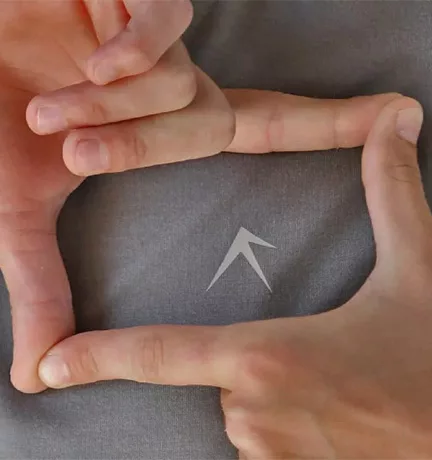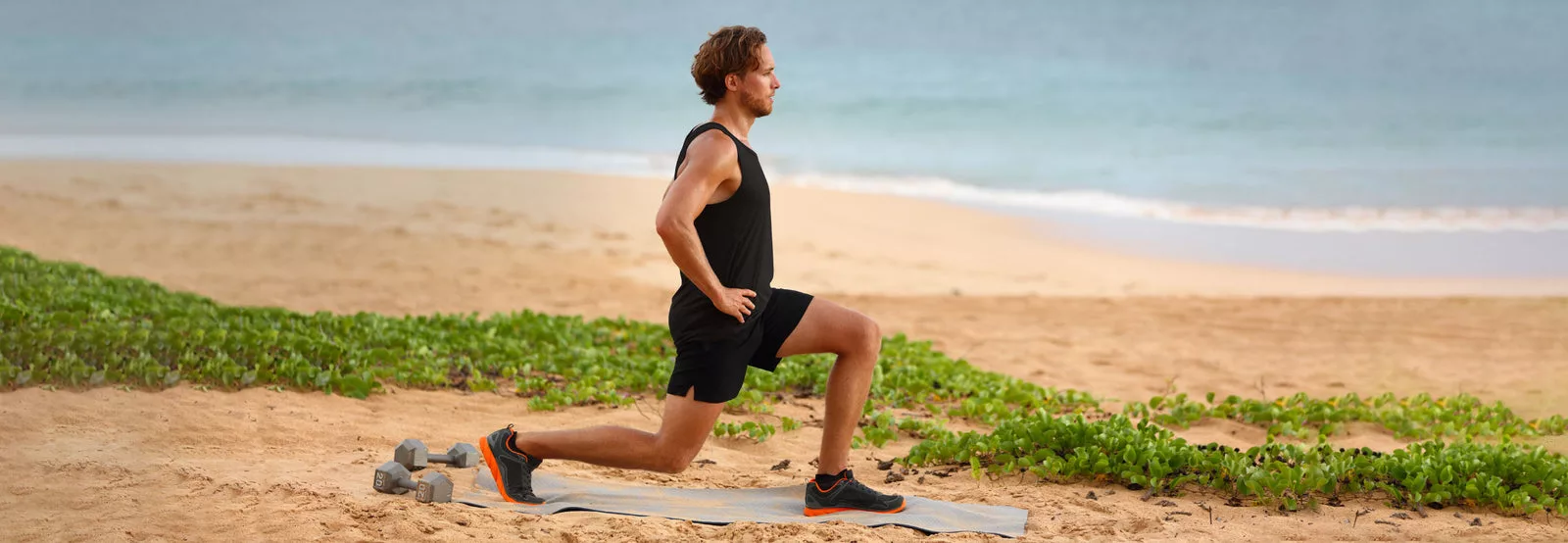Running is a unilateral movement, meaning you use just one limb at a time to continuously propel yourself forward. That’s why it’s so important for us to incorporate unilateral exercises into our regular strength-training workouts. Lunges are one of the best unilateral exercises for those at the start of their fitness journey because they’re low-impact and you can practice them daily with a minimal chance of injury.
Lunges are a must-add to your lower body workout if you want thick, strong legs and improved functionality in everyday life. Not only do they let you build strength and mass, but they’ll also improve your balance, mobility, and core strength.
How to Do a Lunge?
Stand in a split stance with the right foot roughly 2 to 3 feet in front of the left foot. Your torso is straight, your shoulders are back and down, your core is engaged, and your hands are resting on your hips.
Execution:
- Stand in a split stance, with your feet around hip-width apart and your front foot a medium step in front of you.
- Keep in mind that at the bottom of the move, you want your shoulders, hips, and rear knee to be in a straight line while your front knee is bent at 90 degrees with your shin vertical.
- Lower your body down for a count of two, keeping your front foot flat on the ground while your rear heel raises with your big toe acting as an anchor.
- As you move, keep your core tight and your torso upright.
- Hold for a second at the bottom before pushing back up for a count of two to the starting position.
What Muscles Do Lunges Work?
The bulk of the muscles in your lower body, particularly the glutes, quadriceps, and hamstrings, are worked during lunges. However, your adductors, core, and erectors as well as other stabilizing muscles will also feel them.
What Advantages Do Lunges Offer?

What are the Benefits of Lunges?
A multi-joint exercise known as the lunge can help tone and strengthen numerous lower body muscles. This includes the calves, glutes, hamstrings, and quads.
During the lunge, your hip flexors are stretched. This increases their range of motion and prevents the shortening and tightness that might occur with prolonged sitting.
For stability, you also use your core muscles, which can keep you balanced and help you avoid accidents.
Lunges are a useful exercise, which is an additional advantage. In other words, kids imitate behaviors you exhibit in daily life, like picking something up off the floor. Lunges may even increase your metabolism because they use substantial lower-body muscle groups.
Up for a challenge? Try these few lunge variations
- Reverse lunges
The reserve lunge is even more foolproof than the forward variation, and it is much harder to lose balance when performing it. Keep your front foot planted and step back instead of forwards. This exercise targets the quadriceps at the front of your legs.
- Walking lunges
The walking lunge starts at the same point as a forward lunge, but when you have your knees bent, push off your trailing leg and bring it forward into a ‘walking motion’ and repeat. This variation keeps your core engaged and will help to strengthen your mid-body and abdominal muscles.
- Lateral lunges
The lateral lunge, named as such because of its sideways motion, helps with strengthening the core and working on improving balance and coordination. This variation also works a few more muscles in your inner and outer thighs. To complete a lateral lunge, stand upright with a straight back and take a big step to your side with one leg. The trailing leg should stay straight while your leading leg bends to a 90 degrees’ angle. Repeat on the other side.
- Split jump
A split jump lunge will add an explosive movement to your workout, giving you access to plyometric exercise, too. It will also add cardiovascular exercise to your training. The basic premise is a forward lunge, but when your knees are bent, use some explosive power to push off your feet and jump, switching the position of your feet in mid-air. This amazing workout is difficult but can strengthen your core considerably.
- Clock lunges
This variant incorporates forward, reverse, and lateral lunges into one exercise. The basic premise is to complete a clock face of movements. Start with a forward lunge (this is your 12 o’clock). The lateral lunges will be your 3 o’clock and your 9 o’clock with your reverse lunge filling the 6 o’clock position. If you want to test yourself, try and complete it as fast as you can without ever sacrificing your form.
The Most Common Mistakes
Lunges are popular for good reason: you can do them anywhere, they don’t require any equipment, and they’re one of the most effective lower-body workouts. Yet despite the simplicity, lunges are often done with poor form. By recognizing and eliminating these errors, you’ll be able to take full advantage of the fitness benefits of a lunge. It’s worth noting that some forms of mistakes can lead to knee pain, so make sure to keep these tips in mind.
- Don’t lean too far back
When you perform a lunge perfectly, most of the weight should be placed on your forward leg. When you lean back, the benefits of the move are considerably less. The trick is to keep your back straight while engaging your core muscles.
- Keep your front knee behind your toes
While bending the knees into a lunge movement, aim to keep your legs at 90 degrees. By making sure that your knees don’t go over the top of your toes, you’ll protect your quadriceps from any added strain.
- Step with your legs out in a straight line
When you lunge forward, make sure to move your knee forward in a straight line, and not off to either side. Not only will this help to complete the move with perfect execution, but it lessens the chance that you’ll become overbalanced and fall over.
- Stance Too Close or Wide
Each person has a different stance based on height, leg length, and what feels comfortable. However, keeping the feet too close together puts much of the force on the knees while taking them too far apart can compromise flexibility in the back leg and add to an already unstable position. Check your stance by getting into a lunge position. Lower all the way down, resting the back knee on the floor. Doing this allows you to see if you have a 90-degree angle in both knees. If you don’t, adjust your stance.
If you want to start your fitness journey, lunges are a great introduction to getting into shape. Working muscles in your entire lower body, especially the glutes, quads, and hamstrings, is an important way to build body strength and keep your fitness levels up. Once you’ve mastered the basics, there are many ways to evolve the lunge and plenty of variations to jazz it up.
So why not pair our Wizard Speed 2 in 1 Short [5] with Wizardry Tanks [6] and add lunges to your gym routines?
References:
- Paige Waehner, CPT, https://www.verywellfit.com/how-to-lunge-variations-modifications-and-mistakes-1231320
- https://8fit.com/fitness/lunge-variations/
- Alex Linde, https://www.thetrendspotter.net/how-to-do-lunges/
- https://www.wizardathleisure.com/collections/mens-shorts, https://www.wizardathleisure.com/collections/women-shorts
- https://www.wizardathleisure.com/collections/womens-tanks, https://www.wizardathleisure.com/collections/mens-vest















